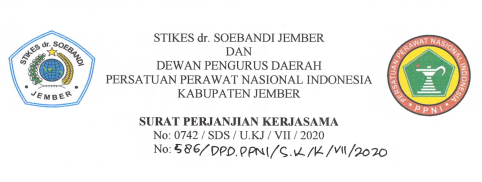Formulation of Polyethylene Glycol Based Ibuprofen Nanosuppository Preparations and Assesment of Dissolution
DOI:
https://doi.org/10.36858/jkds.v12i2.743Keywords:
Nosuppositoria, Ibuprofen, Dissolution TestAbstract
Ibuprofen is widely formulated in oral and rectal dosage forms. Ibuprofen in the rectal route shows c max and t max longer than syrup preparations, this is due to the low solubility of ibuprofen. Nanoparticles are one of the technologies that are widely used to increase the solubility of an active substance. Nanoscale particle size, can increase the solubility of ibuprofen and allow dose reduction. This study aims to formulate ibuprofen nanosuppository preparations, and test the percent dissolution of nanosuppositories compared to conventional suppositories. The ibuprofen nanosuppository formulation consists of ibuprofen lipid component and PEG mix component (PEG 4000: PEG 6000). The ibuprofen lipid component consisted of ibuprofen VCO oil, tween 80 and propylenglycol. This lipid component was then tested for physical characteristics, transmittance, particle size and zeta potential, then the lipid was added to the suppository base component. The responses observed were disintegration time, hardness, and non-intrinsic dissolution efficiency. The test results showed transmittance values of 91.98%, 92.99%, 93.26%. Particle size and potential zeta values of FI = 107, 5 nm, FII 102 nm and FIII 103 nm. The zeta potential were -16.19 mV, -12.44 and -13.25 mV in the lipid component. The test results of the disintegration time of F1, F2, F3 nanosuppositories were 12 minutes, 11 minutes and 10 minutes. The hardness of F1, F2, and F3 were 1.53 kg, 1.43 kg and 1.26 kg and the dissolution efficiency value was higher than conventional suppositories. Modification of ibuprofen nanosuppositories had a significant effect on the percent dissolution of ibuprofen.
References
Abbaspour, M. et al. (2022) ‘Development and Evaluation of Vaginal Suppository Containing Althaea officinalis L. Polysaccharide Extract’, Brazilian Journal of Pharmaceutical Sciences, 58. Available at: https://doi.org/10.1590/s2175-97902022e20868.
Alwan, L.A.H. and Al-Akkam, E.J. (2019) ‘Formulation and in vitro evaluation of piroxicam conventional and hollow suppositories’, International Journal of Applied Pharmaceutics, 11(3), pp. 63–71. Available at: https://doi.org/10.22159/ijap.2019v11i3.31861.
Chandra Sekhara Rao G et al. (2023) ‘A review on suppositories’, GSC Biological and Pharmaceutical Sciences, 25(1), pp. 186–192. Available at: https://doi.org/10.30574/gscbps.2023.25.1.0429.
Handoyo Sahumena, M., Suryani, S. and Rahmadani, N. (2019) ‘Formulasi Self-Nanoemulsifiying Drug Delivery System (SNEDDS) Asam Mefenamat menggunakan VCO dengan Kombinasi Surfaktan Tween dan Span’, Journal Syifa Sciences and Clinical Research, 1(2), pp. 37–46. Available at: https://doi.org/10.37311/jsscr.v1i2.2660.
Hofmann, M. et al. (2020) ‘In vitro prediction of in vivo absorption of ibuprofen from suspensions through rational choice of dissolution conditions’, European Journal of Pharmaceutics and Biopharmaceutics, 149(December 2019), pp. 229–237. Available at: https://doi.org/10.1016/j.ejpb.2020.02.009.
Hua, S. (2019) ‘Physiological and pharmaceutical considerations for rectal drug formulations’, Frontiers in Pharmacology, 10(October), pp. 1–16. Available at: https://doi.org/10.3389/fphar.2019.01196.
Kannadasan, D.M. et al. (2020) ‘a Review: Nano Particle Drug Delivery System’, International Journal of Pharmaceutical Sciences and Medicine, 5(12), pp. 46–58. Available at: https://doi.org/10.47760/ijpsm.2020.v05i12.008.
Katya M.Aguilar-Perez, Dora I, Medina, Roberto Parra-Saldivar, H.M.Ni. (2022) ‘Nano-Size Characterization and Antifungal Evaluation Essential Oil Molecules-Loaded Nanoliposomes’.
Marchaban (2015) ‘Evaluasi pelepasan obat dari supositoria basis lemak : perbedaan antara metode disolusi intrinsik dan non-intrinsik’, Majalah Farmasi Indonesia, 15(4), pp. 163–168.
de Martino, M. et al. (2017) ‘Working Towards an Appropriate Use of Ibuprofen in Children: An Evidence-Based Appraisal’, Drugs, 77(12), pp. 1295–1311. Available at: https://doi.org/10.1007/s40265-017-0751-z.
S.Hargoli, J.Fard, S.H.Azarm, S.Ghanbarzadeh, P.Z.M. (2013) ‘Preparation and In Fitro Evaluation of Naproxen Suppositories’, Indian.J.Pharm.Sci [Preprint].
Silvia, S. (2011) ‘Uji Disolusi Komparatif Tablet Ibuprofen Generik Bermerek dan Generik Berlogo’, Fakultas Farmasi [Preprint]. Available at: http://dx.doi.org/10.1038/ni.1913%0Ahttp://dx.doi.org/10.1016/j.dci.2013.08.014%0Ahttp://dx.doi.org/10.1186/s13071-016-1819-4%0Ahttp://dx.doi.org/10.1016/j.actatropica.2017.02.006%0Ahttp://dx.doi.org/10.1038/s41598-017-09955-y%0Ahttp://dx.doi.org/10.1016/.
Špaglová, M. et al. (2021) ‘Possibilities of microemulsion application in rectal administration of indomethacin’, European Pharmaceutical Journal, 68(1), pp. 94–97. Available at: https://doi.org/10.2478/afpuc-2021-0012.
Sravani, K.S., Renuka, K. and Praveen, K. (2020) ‘Nano particles : A current review’, 9(7), pp. 200–202.
Stefanov, S.R. and Andonova, V.Y. (2021) ‘Lipid nanoparticulate drug delivery systems: Recent advances in the treatment of skin disorders’, Pharmaceuticals, 14(11). Available at: https://doi.org/10.3390/ph14111083.
Downloads
Published
How to Cite
Issue
Section
License
Copyright (c) 2024 Jurnal Kesehatan dr. Soebandi

This work is licensed under a Creative Commons Attribution-NonCommercial-ShareAlike 4.0 International License.




